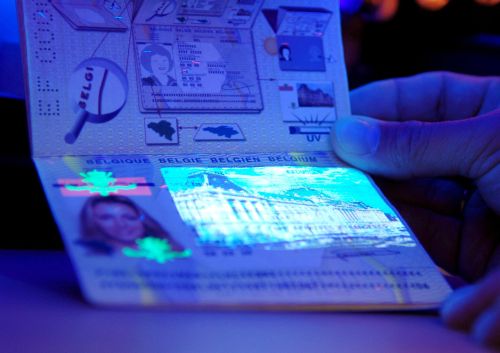To Assurance Policy Assurance Policy - To Assurance Handbook The Assurance Handbook -
To Acceptable documents Acceptable documents
Acceptable documents for Belgian citizens
All Belgians 15 years or older are required by law to carry proof of identity. Police officers can request to see this proof, so any Belgian asking to be assured can be reasonably expected to produce it.
There are two types of identity cards:
- An older, laminated card about 7cm high and 10cm wide, printed in landscape format
- A newer, credit card sized card 5.4cm high and 8.5cm wide, printed in landscape format
Many documents and cards owned by Belgians display the national registry number.
Identification number of the National Register
This is a unique number that never changes over the course of a person's life. The format is YYMMDDAAA-BB, with:
- YYMMDD the year/month/day of birth
- AAA is the day counter for births. AAA should be:
- even for females
- odd for males
- BB is a control number
Older ID cards
This type of ID card is currently being phased out but many people still carry one. It will probably be phased out by 2009, although many cards have validity dates past 2009.
The front side contains the same personal details as the new one (see below), plus the home address.
The back side contains:
An optional registry number (discussed below)
- The same ID card number as displayed on the front
- The full first names of the person if they didn't fit on the front and had to be abbreviated there
- Address changes within the same town or city. Address changes to a different town or city always mean a new card had to be issued (this is why the new card doesn't contain the address)
Newer ID cards
Characteristics that can help you verify the card's authenticity:
- This credit card sized government ID contains the name of the country at the top, in 4 languages (Dutch, French, German and English) and in capital letters: BELGIE BELGIQUE BELGIEN BELGIUM. Below each of these you'll see the word(s) "identity card" printed in smaller, capital letters, and in the same language as the word above it.
- It also has a green arrow to the left of an EMV chip which can be used for digitally signing official documents.
- The photo is in the lower right corner and is partially covered by a "B" inside a circle (difficult to see). The photo is repeated in a small hologram print to the left of the large sized photo, and the numbers printed over this smaller photo are the middle digits of the "registry number", which is repeated in the machine readable print at the back: if the digits "0214110" are printed over the small photo and the person was born in 1986, then the back should contain "BEL860214110" on the middle row. This means that this person was born on 14 February 1986 - please check that the date of birth on the front matches! The registry number is also printed at the top of the backside of the card.
It should light up in magnificent ways when held under UV light

- indeed

- (Image: ANP)
The card contains the following details about the person:
- Name (family name)
- First name(s), only the two leading first names are printed in full, others are abbreviated to a single letter
- Place and date of birth
- Nationality
- ID card number (do not record! Can lead to identity theft!)
- Valid from/until
- Holder's signature
The back contains:
- Identification number of the National Register
- Place of issue
- Signature of authority issuing the card
- Machine readable information
Online governmental tool for checking Belgian documents
http://www.checkdoc.be is a website allowing to anybody to check, anywhere in the world, that a Belgian identity document has well be emitted and wasn't reported as lost, stolen, deprecated or invalid. It is a search engine against the "Registre national" and the national passport database. In a couple of seconds, the user gets a reply such as "HIT" or "NO HIT". The service requires you first to create a login. It can test IDs, eIDs, passports, driving licences etc More info in French, Dutch & German at http://www.ibz.rrn.fgov.be/index.php?id=1284
Other forms of identification
These forms of secondary identification may be useful:
The Belgian driver's license is not considered a valid proof of identity. It does not expire, and licenses from the 1960s are common. The holder's photograph is normally stamped with the seal of the issuing authority. This seal should continue outside the photograph and helps to identify swapped photographs (check if the seal on the photograph and on the paper outside it line up). Many people still carry their original driver's license from when they first started driving, and the photos may be difficult to compare to the person asking to be assured. Use good judgement!
The SIS card (credit card size, with EMV chip) is not considered a valid proof of identity. This card is proof of membership to the government mandated health insurance plan. Its issue is tightly controlled by law. It contains no photograph, but the "Identification number of the National Register" discussed above in the ID card section must match the number displayed prominently at the top right of this card. It also displays the (family) name, first names, date of birth and gender, plus a number at the bottom left and the date of issue at the bottom right.
- Blood donor card. The Red Cross handles blood donations in Belgium, and requires a proof of identity before it will issue a blood donor card. They are easily faked.
- Public library card. Public libraries are normally government owned, and require proof of identity before issuing a library card. They are easily faked.
- Student IDs normally have a photograph on them and sometimes specify date and place of birth. They are easily faked.
